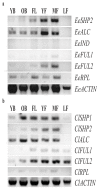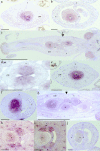Understanding the basis of a novel fruit type in Brassicaceae: conservation and deviation in expression patterns of six genes
- PMID: 22943452
- PMCID: PMC3503883
- DOI: 10.1186/2041-9139-3-20
Understanding the basis of a novel fruit type in Brassicaceae: conservation and deviation in expression patterns of six genes
Abstract
Background: Variation in fruit morphology is important for plant fitness because it influences dispersal capabilities. Approximately half the members of tribe Brassiceae (Brassicaceae) exhibit fruits with segmentation and variable dehiscence, called heteroarthrocarpy. The knowledge of the genetics of fruit patterning in Arabidopsis offers the opportunity to ask: (1) whether this genetic pathway is conserved in taxa with different fruit morphologies; (2) how the pathway may be modified to produce indehiscence; and (3) whether the pathway has been recruited for a novel abscission zone.
Methods: We identified homologs of ALCATRAZ, FRUITFULL, INDEHISCENT, SHATTERPROOF, and REPLUMLESS from two taxa, representing different types of heteroarthrocarpy. Comparative gene expression of twelve loci was assessed to address how their expression may have been modified to produce heteroarthrocarpy.
Results: Studies demonstrated overall conservation in gene expression patterns between dehiscent segments of Erucaria erucarioides and Arabidopsis, with some difference in expression of genes that position the valve margin. In contrast, indehiscence in heteroarthrocarpic fruit segments was correlated with the elimination of the entire valve margin pathway in Erucaria and Cakile lanceolata as well as its absence from a novel lateral abscission zone.
Conclusions: These findings suggest that modifications in the valve margin positioning genes are responsible for differences between heteroarthrocarpic and Arabidopsis-like fruits and support the hypothesis that heteroarthrocarpy evolved via repositioning the valve margin. They also highlight conservation in the dehiscence pathway across Brassicaceae.
Figures





References
-
- Hall JC, Donohue K. In: Dispersal: causes and consequences. Clobert J, Baguette M, Benton T, Bullock J, editor. New York, NY: Oxford University Press; Genetics of Plant Dispersal. in press.
-
- Bolmgren K, Eriksson O. Fleshy fruits - origins, niche shifts, and diversification. Oikos. 2005;109:255–272.
-
- Lorts CM, Briggeman T, Sang T. Evolution of fruit types and seed dispersal: A phylogenetic and ecological snapshot. J Syst Evol. 2008;46:396–404.
-
- Knapp S. Tobacco to tomatoes: a phylogenetic perspective on fruit diversity in the Solanaceae. J Exp Bot. 2002;53:2001–2022. - PubMed
-
- Clausing G, Meyer K, Renner SS. Correlations among fruit traits and evolution of different fruits within Melastomataceae. Bot J Linn Soc. 2000;133:303–326.
LinkOut - more resources
Full Text Sources
Molecular Biology Databases

